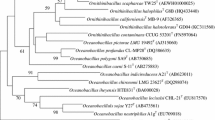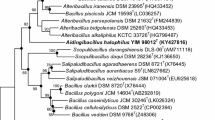Abstract
A novel Gram-stain-positive, motile, moderate halophile, strain L9T, was isolated from hides of white goat in China. The isolate grew optimally at 30 °C, at pH 7 and with 5–10% (w/v) NaCl. The predominant menaquinone was MK-7, and the major cellular fatty acids were identified as iso-C15:0 and anteiso-C15:0. The peptidoglycan amino acid type was determined to be A4β, containing l-ornithine and d-aspartic as diagnostic amino acids. The phospholipids were dominated by diphosphatidylglycerol, phosphatidylglycerol, one unidentified aminophospholipid and two unidentified phospholipids. Genome sequencing resulted in a genome size of 4.0 Mbp and a DNA G + C content of 35.9 mol%. Phylogenetic trees based on the 16S rRNA gene sequences showed the isolate to be closely related to Oceanobacillus limi H9BT (98.2% similarity) and Ornithinibacillus halophilus G8BT (97.5% similarity). The ANI and dDDH values between strain L9T and the closely related species were 69.8–76.1% and 13.0–20.5%, respectively. On the basis of the data presented, strain L9T represents a novel species of the genus Ornithinibacillus, for which the name Ornithinibacillus caprae sp. nov. is proposed. The type strain is L9T (= KCTC 43176T = CGMCC 1.17659T).

Similar content being viewed by others
Abbreviations
- LB:
-
Luria–Bertani
- MK-7:
-
Menaquinone-7
- Orb :
-
Ornithinibacillus
- Ocb :
-
Oceanobacillus
- ANI:
-
Average nucleotide identity
- dDDH:
-
Digital DNA–DNA hybridization
- MEGA:
-
Molecular evolutionary genetics analysis
- KCTC:
-
Korean Collection for Type Cultures
- CGMCC:
-
China General Microbiological Culture Collection Center
References
Amoozegar MA, Bagheri M, Makhdoumi-Kakhki A, Didari M, Schumann P, Sproer C, Sanchez-Porro C, Sanchez-Porro A (2014) Oceanobacillus limi sp. nov., a moderately halophilic bacterium from a salt lake. Int J Syst Evol Microbiol 64:1284–1289
Bagheri M, Amoozegar MA, Schumann P, Didari M, Mehrshad M, Sproer C, Sanchez-Porro C, Ventosa A (2013) Ornithinibacillus halophilus sp. nov., a moderately halophilic, Gram-stain-positive, endospore-forming bacterium from a hypersaline lake. Int J Syst Evol Microbiol 63:844–848
Brettin T, Davis JJ, Disz T, Edwards RA, Gerdes S et al (2015) RASTtk: a modular and extensible implementation of the RAST algorithm for building custom annotation pipelines and annotating batches of genomes. Sci Rep 5:8365
Chun J, Goodfellow M (1995) A phylogenetic analysis of the genus Nocardia with 16S rRNA gene sequences. Int J Syst Bacteriol 45:240–245
Collins MD, Pirouz T, Goodfellow M, Minnikin DE (1977) Distribution of menaquinones in actinomycetes and corynebacteria. J Gen Microbiol 100:221–230
Felsenstein J (1981) Evolutionary trees from DNA sequences: a maximum likelihood approach. J Mol Evol 17:368–376
Felsenstein J (1985) Confidence limits on phylogenies: an approach using the bootstrap. Evolution 39:783–791
Fitch WM (1971) Toward defining the course of evolution: minimum change for a specific tree topology. Syst Zool 20:406–416
Gan LZ, Zhang HM, Long XF, Tian JW, Wang ZK, Zhang YQ, Dai YM, Tian YQ (2018) Ornithinibacillus salinisoli sp. nov., a moderately halophilic bacterium isolated from a saline-alkali soil. Int J Syst Evol Microbiol 68:769–775
Hasegawa T, Takizawa M, Tanida S (1983) A rapid analysis for chemical grouping of aerobic actinomycetes. J Gen Appl Microbiol 29:319–322
Kämpfer P, Kroppenstedt RM (1996) Numerical analysis of fatty acid patterns of coryneform bacteria and related taxa. Can J Microbiol 42:989–1005
Kämpfer P, Falsen E, Lodders N, Langer S, Busse HJ, Schumann P (2010) Ornithinibacillus contaminans sp. nov., an endospore-forming species. Int J Syst Evol Microbiol 60:2930–2934
Kates M (1972) Techniques of lipidology: isolation, analysis and identification of lipids. In: Work TS, Work E (eds) Laboratory techniques in biochemistry and molecular biology, vol 3. Elsevier, Amsterdam, pp 269–610
Kimura M (1980) A simple method for estimating evolutionary rates of base substitutions through comparative studies of nucleotide sequences. J Mol Evol 16:111–120
Kroppenstedt RM (1982) Separation of bacterial menaquinones by HPLC using reverse phase (RP18) and a silver loaded ion exchanger as stationary phases. J Liq Chromatogr 5:2359–2367
Kumar S, Stecher G, Tamura K (2016) MEGA7: molecular evolutionary genetics analysis version 7.0 for bigger datasets. Mol Biol Evol 33:1870–1874
Kushner DJ (1978) Life in high salt and solute concentrations: halophilic bacteria. In: Kushner DJ (ed) Microbial life in extreme environments. Academic Press, London, pp 317–368
Lane DJ (1991) 16S/23S rRNA Sequencing. In: Stackebrandt E, Goodfellow M (eds) Nucleic acid techniques in bacterial systematics. Wiley, New York, pp 115–175
Lee I, Kim YO, Park SC, Chun J (2016) OrthoANI: an improved algorithm and software for calculating average nucleotide identity. Int J Syst Evol Microbiol 66:1100–1103
Lu Q, Yuan H, Li J, Zhao Y, Zhou SG (2015) Ornithinibacillus composti sp. nov. isolated from sludge compost and emended description of the genus Ornithinibacillus. Antonie Van Leeuwenhoek 107:813–819
Lin SH, Liao YC (2013) CISA: contig integrator for sequence assembly of bacterial genomes. PLoS ONE 8:e60843
Luo RB, Liu BH, Xie YL, Li ZY, Huang WH et al (2012) SOAPdenovo2: an empirically improved memory-efficient short-read de novo assembler. Gigascience 1:18
Mata JA, Martínez-Canovas J, Quesada E, Bejar V (2002) A detailed phenotypic characterisation of the type strains of Halomonas species. Syst Appl Microbiol 25:360–375
Mayr R, Busse HJ, Worliczek HL, Ehling-Schulz M, Scherer S (2006) Ornithinibacillus gen. nov., with the species Ornithinibacillus bavariensis sp. nov. and Ornithinibacillus californiensis sp. nov. Int J Syst Evol Microbiol 56:1383–1389
Meier-Kolthoff JP, Auch AF, Klenk HP, Göker M (2013) Genome sequence-based species delimitation with confidence intervals and improved distance functions. BMC Bioinform 14:60
Qu JH, Fu YH, Yue YF, Li HF (2019) Description of Ornithinibacillus gellani sp. nov., a halophilic bacterium isolated from lake sediment, and emended description of the genus Ornithinibacillus. Int J Syst Evol Microbiol 69:2632–2637
Richter M, Rosselló-Móra R (2009) Shifting the genomic gold standard for the prokaryotic species definition. Proc Natl Acad Sci USA 106:19126–19131
Saitou N, Nei M (1987) The neighbor-joining method: a new method for reconstructing phylogenetic trees. Mol Biol Evol 4:406–425
Schaeffer AB, Fulton MD (1933) A simplified method of staining endospores. Science 77:194
Shin NR, Whon TW, Kim MS, Roh SW, Jung MJ, Kim YO, Bae JW (2012) Ornithinibacillus scapharcae sp. nov., isolated from a dead ark clam. Antonie Van Leeuwenhoek 101:147–154
Smibert RM, Krieg NR (1994) Phenotypic characterization. In: Gerhardt P, Murray RGE, Wood WA, Krieg NR (eds) Methods for general and molecular bacteriology. American Society for Microbiology, Washington, DC, pp 607–654
Tian JW, Long XF, Tian YQ, Shi B (2019) Eco-friendly enzymatic dehairing of goatskins utilizing a metalloprotease high-effectively expressed by Bacillus subtilis SCK6. J Clean Prod 212:647–654
Wayne LG, Brenner DJ, Colwell RR, Grimont PAD, Kandler O et al (1987) International committee on systematic bacteriology. Report of the ad hoc committee on the reconciliation of approaches to bacterial systematic. Int J Syst Bacteriol 37:463–464
Xiang W, Liu C, Wang X, Du J, Xi L, Huang Y (2011) Actinoalloteichus nanshanensis sp. nov., isolated from the rhizosphere of a fig tree (Ficus religiosa). Int J Syst Evol Microbiol 61:1165–1169
Xu LH, Li WJ, Liu ZH, Jiang CL (2007) Actinomycete systematic—principle, methods and practice. Science Press, Beijing, pp 54–66
Yoon SH, Ha SM, Kwon S, Lim J, Kim Y, Seo H, Chun J (2017) Introducing EzBioCloud: a taxonomically united database of 16S rRNA gene sequences and whole-genome assemblies. Int J Syst Evol Microbiol 67:1613–1617
Acknowledgements
We thank Prof. Aharon Oren for his valuable help with naming the species. This work is supported by the National Key Research and Development Program of China (2017YFB0308401).
Author information
Authors and Affiliations
Contributions
XL performed the predominant experiments, analysed the data and drafted the manuscript. SZ and CC were responsible for collecting samples. LG contributed to the cell wall peptidoglycan amino acids determination. YT and BS conceived the study and supervised the study. All the authors discussed the results and revised the manuscript.
Corresponding author
Ethics declarations
Conflict of interest
The authors declare that there are no conflicts of interest.
Ethical statement
This article does not contain any studies with human participants and/or animals performed by any of the authors.
Additional information
Communicated by Erko Stackebrandt.
Publisher's Note
Springer Nature remains neutral with regard to jurisdictional claims in published maps and institutional affiliations.
Electronic supplementary material
Below is the link to the electronic supplementary material.
Rights and permissions
About this article
Cite this article
Li, X., Zhang, S., Gan, L. et al. Ornithinibacillus caprae sp. nov., a moderate halophile isolated from the hides of a white goat. Arch Microbiol 202, 1469–1476 (2020). https://doi.org/10.1007/s00203-020-01855-6
Received:
Revised:
Accepted:
Published:
Issue Date:
DOI: https://doi.org/10.1007/s00203-020-01855-6




